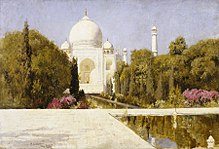Ustad Isa

Ustad Isa Shirazi (Persian: استاد عيسى شیرازی translation Master Isa) was an architect of possible Persian paternal heritage whose ancestors settled in the Indian subcontinent long ago, often described as the assistant architect of the Taj Mahal in Agra, India.[1]
The lack of complete and reliable information as to whom the credit for the design belongs, led to innumerable speculations. Scholars suggest the story of Ustad Isa was born of the eagerness of the British in the 19th century to believe that such a beautiful building should be credited to a European architect. Local informants were reported to have started British curiosity regarding the origins of the Taj by also supplying them with fictitious lists of workmen and materials from all over Asia. Not much is currently known about his background but his surname Shirazi suggests Persian paternal origin and possible mixed Indic-Iranic origin.
Recent research suggests the architect, Ustad Ahmad Lahauri was the most likely candidate as the chief architect of the Taj Mahal, an assertion based on a claim made in writings by Lahauri's son Lutfullah Muhandis.[2][3][4][5]
See also[]
- Taj Mahal- Built (1632-1653)
- Mughal architecture
- Shah Jahan (1628-1707)
Ustad Isa Shirazi was the assistant of Ustad Ahmad Lahori.
Footnotes[]
- ^ (Heather Kissock) Ustad Isa, Chief Designer page 16 Taj Mahal (The Builders including Ustad Isa) via Google Books, Published 2018, Retrieved 18 November 2021
- ^ Taj Mahal Dsecription and Profile UNESCO website, Retrieved 18 November 2021
- ^ Asher, p.212
- ^ Begley and Desai, p.65
- ^ The Age of Splendor (The Reign of Shah Jahan) Columbia University website, Retrieved 18 November 2021
References[]
- A; Desai, Z.A. (1989). Taj Mahal - The Illumined Tomb. University of Washington Press. p. 392. ISBN 978-0-295-96944-2.
- Koch, Ebba (Aug 2006). The Complete Taj Mahal: And the Riverfront Gardens of Agra (First ed.). Thames & Hudson Ltd. ISBN 0-500-34209-1.
- Mughal architecture
- 17th-century architects
- Mughal Empire people
- Indian architects